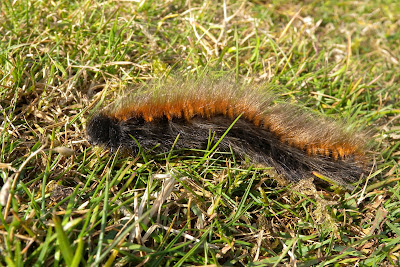We all like good-looking wildlife - weird and wonderful creatures that set the pulse racing. However, I am also a fan of weirdly-named wildlife. The creatures that when you look up their name in a book gets you wondering
how on earth did they come up with that? When you get the combination of the good looking, and the fantastically named it does not get much better. I was blessed to find four such specimens on my evening walk yesterday. It started when I left the house for a walk up Batch Valley and found this lurking on my front door step.
A bit of investigation tells me that this is
the drinker, a moth with a name I can sometimes relate to. But this does not gets its name from being attracted to alcoholic beverages (a light ale perhaps?), but rather the caterpillars apparent liking for drops of dew. If you don't think this is an especially interesting looking creature, then look again at the comb-like antennae. Utterly remarkable.
One thing you may be able to accuse the drinker of is being legless, which is something it has in common with the next creature I discovered.
Slow worms are simply fantastic creatures. A shimmering slither of coppery irridescence, this gorgeous lizard was uncharacteristically out in the open basking on a step. Slow worms don't just look great, they are also fascinating to boot. Being a legless lizard is interesting enough, with an ability to automotize (drop their tail to you and me) when challenged by predators is another incredible adaptation. They are also a gardeners friend for their preference for munching on slugs, which seemed to be out in abundance yesterday evening.
Feeling rather chipper about my slow worm encounter I continued up Batch Valley and soon found one of these wandering across the path.
This may look like a fairly ordinary beetle, but I think all beetles are great-looking things. This has the benefit of having the best name yet -
bloody-nosed beetle. It is so-called because of its habitat of producing bright red fluid from its mouth when challenged. This is both a visual deterrant and foul-tasting, so a great predator avoidance strategy. I didn't want a demonstartion of this unusual skill, so I let the beetle go quietly about its business.
On getting back to my garden it was nice to finally see some butterflies taking advantage of the flowers, after a complete absense of them for most of the year. Amongst the meadow browns was this handsome specimen.
Of course this is a
red admiral, in my opinion one of our best looking insects. A familiar creature, but why is this called after a naval officer? Well, apparently it isn't. A quick look on google tells me that the name derives from a corruption of the 18th century name of 'red admirable'. I don't know if this is true, but if so this is an insect that has been admired over centuries, and rightly so.




















































